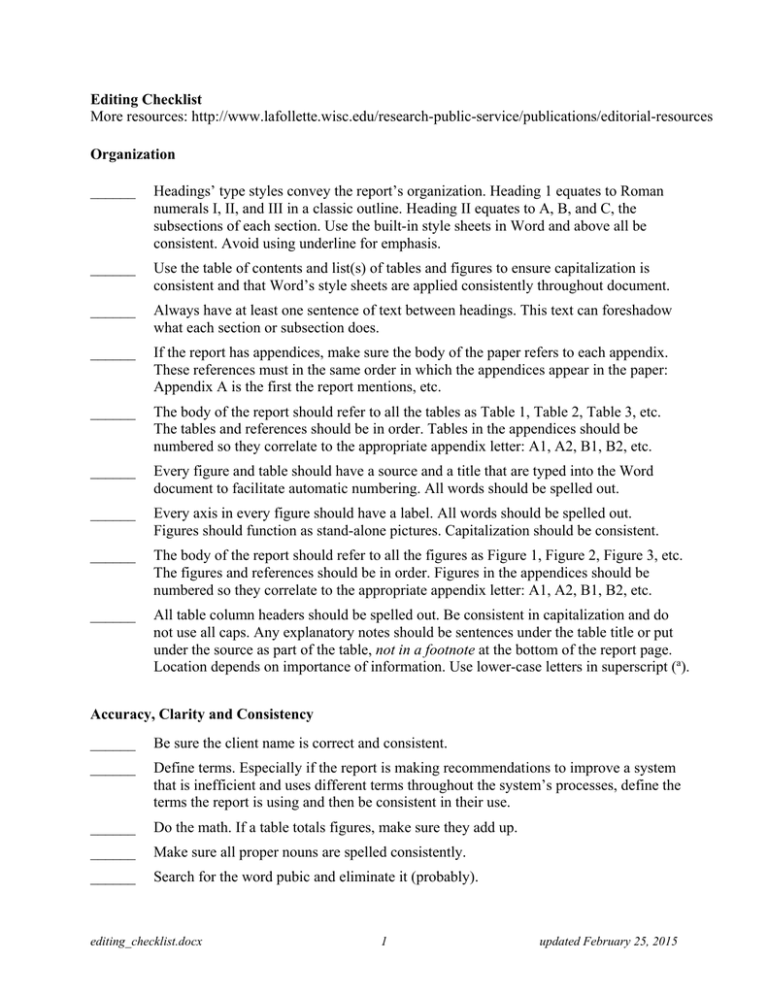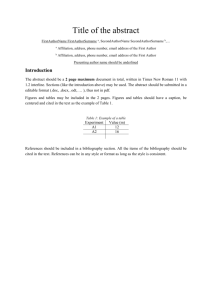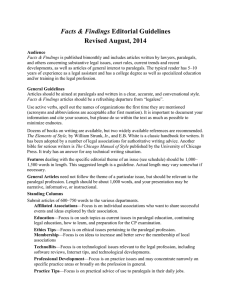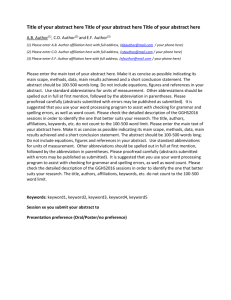Editing Checklist
advertisement

Editing Checklist More resources: http://www.lafollette.wisc.edu/research-public-service/publications/editorial-resources Organization ______ Headings’ type styles convey the report’s organization. Heading 1 equates to Roman numerals I, II, and III in a classic outline. Heading II equates to A, B, and C, the subsections of each section. Use the built-in style sheets in Word and above all be consistent. Avoid using underline for emphasis. ______ Use the table of contents and list(s) of tables and figures to ensure capitalization is consistent and that Word’s style sheets are applied consistently throughout document. ______ Always have at least one sentence of text between headings. This text can foreshadow what each section or subsection does. ______ If the report has appendices, make sure the body of the paper refers to each appendix. These references must in the same order in which the appendices appear in the paper: Appendix A is the first the report mentions, etc. ______ The body of the report should refer to all the tables as Table 1, Table 2, Table 3, etc. The tables and references should be in order. Tables in the appendices should be numbered so they correlate to the appropriate appendix letter: A1, A2, B1, B2, etc. ______ Every figure and table should have a source and a title that are typed into the Word document to facilitate automatic numbering. All words should be spelled out. ______ Every axis in every figure should have a label. All words should be spelled out. Figures should function as stand-alone pictures. Capitalization should be consistent. ______ The body of the report should refer to all the figures as Figure 1, Figure 2, Figure 3, etc. The figures and references should be in order. Figures in the appendices should be numbered so they correlate to the appropriate appendix letter: A1, A2, B1, B2, etc. ______ All table column headers should be spelled out. Be consistent in capitalization and do not use all caps. Any explanatory notes should be sentences under the table title or put under the source as part of the table, not in a footnote at the bottom of the report page. Location depends on importance of information. Use lower-case letters in superscript (a). Accuracy, Clarity and Consistency ______ Be sure the client name is correct and consistent. ______ Define terms. Especially if the report is making recommendations to improve a system that is inefficient and uses different terms throughout the system’s processes, define the terms the report is using and then be consistent in their use. ______ Do the math. If a table totals figures, make sure they add up. ______ Make sure all proper nouns are spelled consistently. ______ Search for the word pubic and eliminate it (probably). editing_checklist.docx 1 updated February 25, 2015 ______ Give specific dates instead of saying, for example, “recently,” “last year” or “in the past decade.” ______ DO NOT USE ALL CAPS. THEY ARE HARD TO READ. ______ Do not abbreviate something that is used five times or less, and try to only use abbreviations common to everyday language. Spell out on first reference. Avoid making up abbreviations for entities that are not already proper nouns. Avoid using abbreviations when presenting report to people outside your agency to avoid appearance of a coded language that inadvertently excludes them or makes them feel ignorant. Don’t define an abbreviation and then not use it within the next two pages. Wait to define it until it is to be used frequently and more than twice. Do not include an abbreviations list unless the report follows the above criteria AND uses more than 10 uncommon abbreviations more than five times each. Tighten the prose: Use the find function in Word to locate these words and phrases in bold and then improve the writing: ______ ______ ______ ______ ______ ______ ______ ______ current(ly), present(ly), past and future can almost always be deleted as the verb tense conveys the time element there: Recast sentences and phrases starting with “there are,” “there were,” etc. so they start with concrete nouns: There are seven dogs barking becomes Seven dogs bark. this: make sure a concrete noun follows: This is a good idea becomes This proposal is a good idea. responsible for, intended to, goal of, and designed to: If something actually occurs and report does not mean to hedge, these phrases can often be deleted: The board is responsible for approving the budget becomes The board approves the budget. The increase in cost is intended to reduce the number of commuters becomes The increase in cost would reduce the number of commuters. The goal of the program is to increase homeownership becomes The program will increase homeownership. The program is designed to increase homeownership becomes The program increases homeownership. in order can almost always be deleted in order to save space. and also is redundant, as is In addition ... also. Search first for was, then were, then by, to eliminate passive voice. Start each sentence or phrase with the noun taking the action: Tuition was raised by the regents becomes The regents raised tuition. unique should be deleted. Instead use concrete language to illustrate how program is unique: The program is unique becomes The program is the only one in the state that has mentors continue working with the teens after they graduate from high school and start jobs or college. Show, don’t tell. editing_checklist.docx 2 updated February 25, 2015 ______ ______ ______ ______ ______ is and are. Find these so verbs can be strengthened and language tightened: is providing becomes provides and are offering becomes offers impacted is never a verb unless “wedged” is meant. Substitute affected. negatively affect should be harm. unfortunately, fortunately, only. Delete these words as they convey opinion and make prose flabby. either usually can be deleted if sentence uses “or”: I’ll have either bratwurst or tofu. Simple Style Rules to Follow for Numbers ______ Only use numerals after the decimal point if the fractions are essential to the meaning of the text, table or figure. Be consistent in the number of numerals used after the decimal point, and do not use more than two numerals after the decimal point. Reading “The increase of 12 percent” is MUCH easier than reading “The increase of 11.58 percent.” In addition, use of a whole number makes starting a sentence much easier. ______ Be consistent in use of percent vs. %. ______ If a percentage is less than 1, use a zero before the decimal: 0.3 percent or 0.05 percent. ______ “percentage” is the noun. ______ Be consistent throughout the report in whether numbers are words or figures. Preferred rule is 10 and greater are figures and zero to nine are words. ______ For American currency use: $5, $6.89, $6 million, $5.7 billion, 3 cents. Do not use $.03. ______ For page numbers, use lower-case Roman numerals iii, iv, etc. for front matter – the list of tables, acknowledgments, executive summary, etc. For the body of the report, use Arabic numerals, 1, 2, 3, etc. Reference List1 ______ A report should have a list of works cited, in addition to citations. ______ Make sure all the references present information in same order and are complete. ______ Make sure all references are capitalized, italicized and punctuated consistently. ______ Make sure all references from the internet are complete: author (if one), publishing agency, complete date document was retrieved. Be sure punctuation and wording are consistent. 1 A reference list can also be called a works cited list. Both include just the materials cited in the report. A bibliography is more extensive; it includes all materials used in the research. editing_checklist.docx 3 updated February 25, 2015 ______ If using endnotes or footnotes, the numbers are 1, 2, 3.2 Citations ______ Citations (parenthetical or foot/endnotes) must be complete, and consistent in capitalization and punctuation. To follow Chicago, do not use a comma or &. ______ Each author’s name must be consistent (and correct) throughout report. Harmonized Citations and Reference List ______ Crosscheck every citation (or foot/endnote) against the works cited list to make sure every citation is listed in the references and every item in the works cited list is actually cited. ______ Make sure each citation-reference pair doesn’t contradict each other (author spelled two ways, for example). Format of Report: The writer needs to ask the client and project manager what the end product will look like and how much time is needed for editing, production and distribution For reports to be printed and bound ______ Center the page numbers throughout the report. ______ Set the left and right margins at 1.5 inches throughout the report. ______ Set the top and bottom margins 1 inch throughout the report. On landscaped (horizontal) pages, the top and bottom margins MUST be 1.5 inches. Left and right can then be 1 inch. For reports to be distributed electronically OR as printed and bound copies ______ Make sure the cover page includes title, authors, client name, date, authors’ affiliation (La Follette School of Public Affairs)? School logo available at http://www.lafollette.wisc.edu/formedia.html#logos ______ Set body copy in 12-point type and align it left (not justified). For reports to be read on paper, use a serif font such as Cambria, Times New Roman or Garamond. Serif type is easier to read. ______ Ensure the sides of the tables and figures fit INSIDE the margins. Note that Word’s default places left side of tables with borders outside the left margin, so centering table on page is easiest. ______ Be consistent with the fonts used in tables and figures. Data should be in 10- to 12-point type, depending on the design and can be in a sans serif font like Calibri, Arial or Helvetica (a narrow version is often perfect for tables and figures). Be sure figures and tables can be read in black and white, in case readers do not have color printers. 2 This paragraph is a footnote. An endnote looks just like it but is placed with all the other endnotes at the end of the report. editing_checklist.docx 4 updated February 25, 2015




